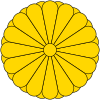Arsitektur Jepang

Arsitektur Jepang (日本建築, Nihon kenchiku) secara tradisional dikhaskan dengan struktur berkayu, meninggi dari bawah, dengan atap genteng atau jerami. Pintu geser (fusuma) dipakai di bagian tembok, membolehkan ketersediaan ruang bagian dalam yang disesuaikan untuk keperluan berbeda. Orang-orang biasanya duduk jongkok atau dengan cara lainnya di atas lantai, secara tradisional; kursi dan meja tinggi tidak banyak dipakai sampai abad ke-20. Namun, sejak abad ke-19, Jepang telah memasukkan sebagian besar arsitektur Barat, modern, dan pasca-modern ke dalam pembangunan dan perancangan, dan sekarang menjadi bagian utama dalam rancangan dan teknologi arsitektural berbasis pemotongan.
Arsitektur Jepang terawal telah ada pada zaman pra-sejarah dengan ruang dan rumah kecil sederhana yang diadaptasi untuk kebutuhan masyarakat pemburu-peramu. Pengaruh dari Dinasti Han Tiongkok melalui Korea memberikan pengenalan lebih kompleks terhadap gudang hasil panen dan kurang pemakaman seremonial.
Galeri
[sunting | sunting sumber]-
Kuil Budha Ikaruga-dera
-
Kastil di Inuyama, Taishi, Prefektur Hyōgo
-
Kuil Ninnaji di Kyoto
-
Bunsho-kan di Kasajima, Prefektur Kagawa
-
Istana Ninomaru, Kyoto
Catatan dan referensi
[sunting | sunting sumber]Daftar pustaka
[sunting | sunting sumber]- Bognar, Botond (1995). The Japan Guide. Princeton Architectural Press. ISBN 1-878271-33-4.
- Bussagli, Mario (1989). History of World Architecture – Oriental Architecture/2. Faber and Faber. ISBN 0-571-15378-X.
- Bowring, R. and Kornicki, P. (1993), The Cambridge Encyclopedia of Japan, pp. 201–208, Cambridge University Press, ISBN 0-521-40352-9.
- Coaldrake, William H. (1996) Architecture and Authority in Japan (Nissan Institute/Routledge Japanese Studies Series), Routledge, ISBN 978-0-415-10601-6
- Daniell, Thomas (2008) After the Crash: Architecture in Post-Bubble Japan, Princeton Architectural Press, ISBN 978-1-56898-776-7
- Diefendorf, Jeffry M; Hein, Carola; Yorifusa, Ishida, ed. (2003). Rebuilding Urban Japan After 1945. Hampshire, United Kingdom: Palgrave MacMillan. ISBN 0-333-65962-7.
- Fiévé, Nicolas (1996).L'architecture et la ville du Japon ancien. Espace architectural de la ville de Kyôto et des résidences shôgunales aux XIVe et XVe siècles, Bibliothèque de l'Institut des Hautes Études Japonaises, Collège de France, Paris, Maisonneuve & Larose, 358 pages + 102 illustrations. ISBN 2-7068-1131-5.
- Fiévé, Nicolas (dir.) (2008).Atlas historique de Kyôto. Analyse spatiale des systèmes de mémoire d’une ville, de son architecture et de ses paysages urbains. Foreword Kôichirô Matsuura, Preface Jacques Gernet, Paris, Éditions de l’UNESCO / Éditions de l’Amateur, 528 pages, 207 maps et 210 ill. ISBN 978-2-85917-486-6.
- Fiévé, Nicolas and Waley, Paul. (2003). Japanese Capitals in Historical Perspective: Place, Power and Memory in Kyoto, Edo and Tokyo. London: Routledge. 417 pages + 75 ill. ISBN 978-0-7007-1409-4
- Frampton, Kenneth (1990). Modern Architecture a Critical History. Thames and Hudson.
- Gotō, Osamu (2003). Nihon Kenchikushi. Kyoritsu Shuppan.
- Gregory, Rob, August 2007, "Reading Matter", Architectural Review
- Gregory, Rob, August 2007, "Rock Solid", Architectural Review
- Itoh, Teiji (1973). Kura – Design and Tradition of the Japanese Storehouse. Kodansha International. ISBN 0-914842-53-6.
- Mitchelhill, Jennifer (2013). Castles of the Samurai:Power & Beauty. USA: Kodansha. ISBN 978-1568365121.
- Nishi, Kazuo; Hozumi, Kazuo (1996) [1983]. What is Japanese architecture? (edisi ke-illustrated). Kodansha International. ISBN 4-7700-1992-0. Diakses tanggal November 11, 2009.
- Payne, James, March 2010, "Lausanne", Architecture Today
- Reynolds, Jonathan M. (2001). Maekawa Kunio and the Emergence of Japanese Modernist Architecture. University of California Press. ISBN 0-520-21495-1.
- Sickman & Soper, Laurence & Alexander (1956). The Art and Architecture of China. Penguin Books.
- Slessor, Catherine, October 2001, "Comment", Architectural Review
- Slessor, Catherine, October 2001, "Common Ground", Architectural Review
- Stewart, David B (2002). The Making of a Modern Japanese Architecture, From the Founders to Shinohara and Isozaki. Kodansha International.
- Sumner, Yuki; Pollock, Naomi (2010). New Architecture in Japan. London: Merrell. ISBN 978-1-85894-450-0.
- Takasaki, Masaharu (1998). An Architecture of Cosmology. Princeton Architectural Press.
- Tanigawa, Masami (2008). Yamamura House – Yodoko Guest House. Banana Books.
- Thompson, Jessica Cargill (2000). 40 architects under 40. Taschen. ISBN 3-8228-6212-6.
- Legault, Réjean; Goldhagen, Sarah, ed. (2000). Anxious Modernisms. Cambridge, Massachusetts: The MIT Press. ISBN 0-262-07208-4.
- Webb, Michael, October 2001, "Layered Media", Architectural Review
- Webb, Michael, May 2006, "Container Art", Architectural Review
- Spring 2005, "Do_co,mo.mo Japan: the 100 selection", The Japan Architect, No. 57
- Fletcher, Banister; Cruickshank, Dan, Sir Banister Fletcher's a History of Architecture, Architectural Press, 20th edition, 1996 (first published 1896). ISBN 0-7506-2267-9. Cf. Part Four, Chapter 25
- Koji Yagi (text), Ryo Hata (photos): A Japanese Touch For Your Home. Kodansha International, Tokyo, New York, London 1999 (Pbck.), ISBN 4-7700-1662-X
Pranala luar
[sunting | sunting sumber]- mooponto.com — the only web magazine devoted to Japanese minimalist architecture.
- JAANUS (Japanese Architecture and Art Net Users System) on-line dictionary of Japanese architectural and art historical terminology
- The Herbert Offen Research Collection of the Phillips Library at the Peabody Essex Museum Diarsipkan 2010-01-30 di Wayback Machine.









